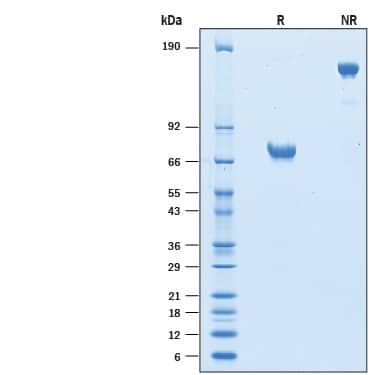Recombinant Human CD200 Fc Chimera Avi-tag Protein, CF
R&D Systems, part of Bio-Techne | Catalog # AVI2724

Key Product Details
Source
Accession #
Structure / Form
Conjugate
Applications
Product Specifications
Source
| Human CD200 (Gln31-Gly232) Accession # P41217 |
IEGRMDP | Human IgG1 (Pro100-Lys330) |
Avi-tag |
| N-terminus | C-terminus | ||
Purity
Endotoxin Level
N-terminal Sequence Analysis
Predicted Molecular Mass
SDS-PAGE
Activity
When Recombinant Human CD200R1 Fc Chimera (Catalog # 3414-CD) is immobilized at 2 μg/mL (100 μL/well), the concentration of Recombinant Human CD200 Fc Chimera Avi-tag (Catalog # AVI2724) that produces 50% of the optimal binding response is 2-10 ng/mL.
Scientific Data Images for Recombinant Human CD200 Fc Chimera Avi-tag Protein, CF
Recombinant Human CD200 Fc Chimera Avi-tag Protein Binding Activity
When Recombinant Human CD200R1 Fc Chimera (Catalog # 3414-CD) is immobilized at 2 µg/mL (100 µL/well), Biotinylated Recombinant Human CD200 Fc Chimera Avi-tag (Catalog # AVI2724) binds with an ED50 of 2-10 ng/mL.Recombinant Human CD200 Fc Chimera Avi-tag Protein SDS-PAGE
2 μg/lane of Biotinylated Recombinant Human CD200 Fc Chimera Avi-tag Protein (Catalog # AVI2724)was resolved with SDS-PAGE under reducing (R) and non-reducing (NR) conditions and visualized by Coomassie® Blue staining, showing bands at 60-80 kDa.Formulation, Preparation and Storage
AVI2724
| Formulation | Lyophilized from a 0.2 μm filtered solution in PBS with Trehalose. |
| Reconstitution | Reconstitute at 500 μg/mL in PBS. |
| Shipping | The product is shipped at ambient temperature. Upon receipt, store it immediately at the temperature recommended below. |
| Stability & Storage | Use a manual defrost freezer and avoid repeated freeze-thaw cycles.
|
Background: CD200
CD200, also known as OX-2, is a 45 kDa transmembrane immunoregulatory protein that belongs to the immunoglobulin superfamily (1, 2). The human CD200 cDNA encodes a 278 amino acid (aa) precursor that includes a 30 aa signal sequence, a 202 aa extracellular domain (ECD), a 27 aa transmembrane segment, and a 19 aa cytoplasmic domain. The ECD is composed of one Ig-like V-type domain and one Ig-like C2-type domain (3). A splice variant of CD200 has been described and has a truncated cytoplasmic tail. Within the ECD, human CD200 shares 76% aa sequence identity with mouse and rat CD200. CD200 is widely but not ubiquitously expressed (4). Its receptor (CD200R) is restricted primarily to mast cells, basophils, macrophages, and dendritic cells, which suggests myeloid cell regulation as the major function of CD200 (5-7). CD200 knockout mice are characterized by increased macrophage number and activation and are predisposed to autoimmune disorders (8). CD200 and CD200R associate via their respective N-terminal Ig-like domains (9). In myeloid cells, CD200R initiates inhibitory signals following receptor-ligand contact (6, 7, 10). In T cells, however, CD200 functions as a costimulatory molecule independent of the CD28 pathway (11). Several additional CD200R-like molecules have been identified in human and mouse, but their capacity to interact with CD200 is controversial (12, 13). Several viruses encode CD200 homologs which are expressed on infected cells during the lytic phase (14, 15). Like CD200 itself, viral CD200 homologs also suppress myeloid cell activity, enabling increased viral propagation (5, 14-16).
References
- Gorczynski, R.M. (2005) Curr. Opin. Invest. Drugs 6:483.
- Barclay, A.N. et al. (2002) Trends Immunol. 23:285.
- McCaughan, G.W. et al. (1987) Immunogenetics 25:329.
- Wright, G.J. et al. (2001) Immunology 102:173.
- Shiratori, I. et al. (2005) J. Immunol. 175:4441.
- Cherwinski, H.M. et al. (2005) J. Immunol. 174:1348.
- Fallarino, F. et al. (2004) J. Immunol. 173:3748.
- Hoek, R.M. et al. (2000) Science 290:1768.
- Hatherley, D. and A.N. Barclay (2004) Eur. J. Immunol. 34:1688.
- Jenmalm, M.C. et al. (2006) J. Immunol. 176:191.
- Borriello, F. et al. (1997) J. Immunol. 158:4548.
- Gorczynski, R. et al. (2004) J. Immunol. 172:7744.
- Hatherley, D. et al. (2005) J. Immunol. 175:2469.
- Foster-Cuevas, M. et al. (2004) J. Virol. 78:7667.
- Cameron, C.M. et al. (2005) J. Virol. 79:6052.
- Langlais, C.L. et al. (2006) J. Virol. 80:3098.
Alternate Names
Gene Symbol
UniProt
Additional CD200 Products
Product Documents for Recombinant Human CD200 Fc Chimera Avi-tag Protein, CF
Product Specific Notices for Recombinant Human CD200 Fc Chimera Avi-tag Protein, CF
For research use only

